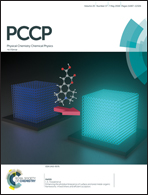The surprisingly high ligation energy of CO to ruthenium porphyrins†
Abstract
A combined theoretical and experimental approach has been used to investigate the binding energy of a ruthenium metalloporphyrin ligated with CO, ruthenium tetraphenylporphyrin [RuII TPP], in the RuII oxidation degree. Measurements performed with VUV ionization using the DESIRS beamline at Synchrotron SOLEIL led to adiabatic ionization energies of [RuII TPP] and its complex with CO, [RuII TPP–CO], of 6.48 ± 0.03 eV and 6.60 ± 0.03 eV, respectively, while the ion dissociation threshold of [RuII TPP–CO]+ is measured to be 8.36 ± 0.03 eV using the ground-state neutral complex. These experimental data are used to derive the binding energies of the CO ligand in neutral and cationic complexes (1.88 ± 0.06 eV and 1.76 ± 0.06 eV, respectively) using a Born–Haber cycle. Density functional theory calculations, in very satisfactory agreement with the experimental results, help to get insights into the metal–ligand bond. Notably, the high ligation energies can be rationalized in terms of the ruthenium orbital structure, which is singular compared to that of the iron atom. Thus, beyond indications of a strengthening of the Ru–CO bond due to the decrease in the CO vibrational frequency in the complex as compared to the Fe–CO bond, high-level calculations are essential to accurately describe the metal ligand (CO) bond and show that the Ru–CO bond energy is strongly affected by the splitting of triplet and singlet spin states in uncomplexed [Ru TPP].

- This article is part of the themed collection: 2018 PCCP HOT Articles


 Please wait while we load your content...
Please wait while we load your content...